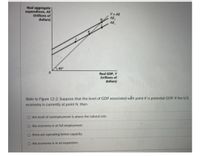
ENGR.ECONOMIC ANALYSIS
14th Edition
ISBN: 9780190931919
Author: NEWNAN
Publisher: Oxford University Press
expand_more
expand_more
format_list_bulleted
Question

Transcribed Image Text:Real aggregate
expenditure, AE
(trillions of
dollars)
Y AE
AE,
45
Real GDP, Y
(trillions of
dollars)
Refer to Figure 12-2. Suppose that the level of GDP associated with point K is potential GDP. If the U.S.
economy is currently at point N, then
O the level of unemployment is above the natural rate.
O the economy is at full employment.
O firms are operating below capacity.
O the economy is in an expansion.
Expert Solution
This question has been solved!
Explore an expertly crafted, step-by-step solution for a thorough understanding of key concepts.
This is a popular solution
Trending nowThis is a popular solution!
Step by stepSolved in 2 steps

Knowledge Booster
Learn more about
Need a deep-dive on the concept behind this application? Look no further. Learn more about this topic, economics and related others by exploring similar questions and additional content below.Similar questions
- Nonearrow_forwardPrice level (CPT) 110 105 100 95 AS Ful employment, 50 151 Real GDP AD₁ (trillions of dollars per year) Suppose the economy in Exhibit 11-2 is in equilibrium at point E, and the marginal propensity to consume (MPC) is 0.75. Following Keynesian economics, the federal government can move the economy to full employment at point E₂ by: A increasing government tax revenue by approximately $33 billion. B decreasing government tax revenue by $100 billion. increasing government tax revenue by $100 billion. decreasing government tax revenue by $750 billion. decreasing government tax revenue by approximately $33 billion.arrow_forward(Figure: Shifts of the AD–AS Curves) Use Figure: Shifts of the AD–AS Curves. A decrease in wages in the short run is illustrated by panel:arrow_forward
- In the first quarter of 2020, US real GDP declined about 9%, due to the economics shocks from the Covid 19 virus. If prices were completely flexible, and this means all prices, both inputs (such as labor), as well as output prices, what would you think would have been the drop in GDP? If prices are completely fixed, would the drop in GDP be greater or less than the flexible case? Why? If the Expenditure method of accounting for GDP, has to equal the Income Side, and the economy overproduces a particular item, say automobiles, the income side will also be higher, workers will buy the extra cars with extra income and the economy can gyrate indefinitely higher? Why or why not?arrow_forward40 AD3 38 - AS 36 - AD 2 34 - 32- AD, 30 - 28 - 26 24 - 22 - 20 4 10 12 14 16 18 20 Real Output (quantity in billions per year) Suppose the economy is at full employment when AD = AD3. a. The GDP gap when the demand curve is at AD1 is billion b. The shortfall when the demand curve is at AD1 is billion Price Level (average price)arrow_forwardWhat is the contractionary phase of the business cycle characterized by? O reduced output and increased unemployment increased output and increased unemployment reduced output and reduced unemployment increased output and reduced unemploymentarrow_forward
- The macroeconomy is depicted by the graph to the right 160- a. The current equilibrium price level and output level respectively are: 80 and $ 10 trillion. (Enter your responses as a whole numbers.) LRAS 140- b. The full employment level of GDP is SRAS O A. $10 trillion since the LRAS is defined at this point. 120- O B. unknown since no information was provided about the labor market. 100- O C. $10 trillion now but thereafter it depends on what the aggregate demand curve does. O D. $10 trillion now but it depends on the SRAS curve. 80- 60- AD 40- 10 12 14 16 18 20 Real GDP ($ trillions) Price levelarrow_forwardTyped plz and asap thanksarrow_forwardRefer to the figure below. Which of the points in the above graph are possible short-run equilibria? Price level (GDP deflator, 2000 = 100) O A and B O A and C O A and D O A, B, C, and D LRAS SRAS, SRAS₂ AD₂ AD₁ Real GDP (trillions of 2000 dollars)arrow_forward
arrow_back_ios
arrow_forward_ios
Recommended textbooks for you

 Principles of Economics (12th Edition)EconomicsISBN:9780134078779Author:Karl E. Case, Ray C. Fair, Sharon E. OsterPublisher:PEARSON
Principles of Economics (12th Edition)EconomicsISBN:9780134078779Author:Karl E. Case, Ray C. Fair, Sharon E. OsterPublisher:PEARSON Engineering Economy (17th Edition)EconomicsISBN:9780134870069Author:William G. Sullivan, Elin M. Wicks, C. Patrick KoellingPublisher:PEARSON
Engineering Economy (17th Edition)EconomicsISBN:9780134870069Author:William G. Sullivan, Elin M. Wicks, C. Patrick KoellingPublisher:PEARSON Principles of Economics (MindTap Course List)EconomicsISBN:9781305585126Author:N. Gregory MankiwPublisher:Cengage Learning
Principles of Economics (MindTap Course List)EconomicsISBN:9781305585126Author:N. Gregory MankiwPublisher:Cengage Learning Managerial Economics: A Problem Solving ApproachEconomicsISBN:9781337106665Author:Luke M. Froeb, Brian T. McCann, Michael R. Ward, Mike ShorPublisher:Cengage Learning
Managerial Economics: A Problem Solving ApproachEconomicsISBN:9781337106665Author:Luke M. Froeb, Brian T. McCann, Michael R. Ward, Mike ShorPublisher:Cengage Learning Managerial Economics & Business Strategy (Mcgraw-...EconomicsISBN:9781259290619Author:Michael Baye, Jeff PrincePublisher:McGraw-Hill Education
Managerial Economics & Business Strategy (Mcgraw-...EconomicsISBN:9781259290619Author:Michael Baye, Jeff PrincePublisher:McGraw-Hill Education


Principles of Economics (12th Edition)
Economics
ISBN:9780134078779
Author:Karl E. Case, Ray C. Fair, Sharon E. Oster
Publisher:PEARSON

Engineering Economy (17th Edition)
Economics
ISBN:9780134870069
Author:William G. Sullivan, Elin M. Wicks, C. Patrick Koelling
Publisher:PEARSON

Principles of Economics (MindTap Course List)
Economics
ISBN:9781305585126
Author:N. Gregory Mankiw
Publisher:Cengage Learning

Managerial Economics: A Problem Solving Approach
Economics
ISBN:9781337106665
Author:Luke M. Froeb, Brian T. McCann, Michael R. Ward, Mike Shor
Publisher:Cengage Learning

Managerial Economics & Business Strategy (Mcgraw-...
Economics
ISBN:9781259290619
Author:Michael Baye, Jeff Prince
Publisher:McGraw-Hill Education